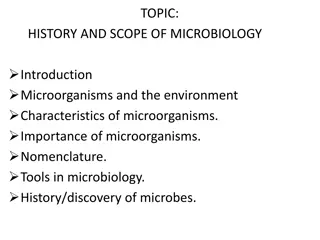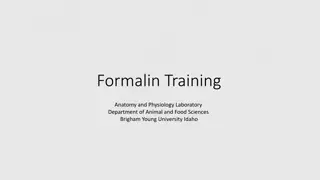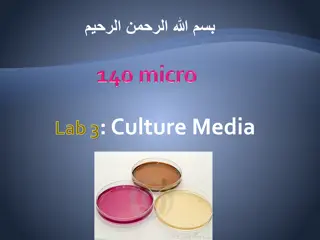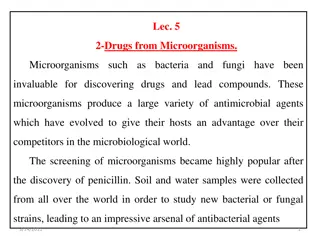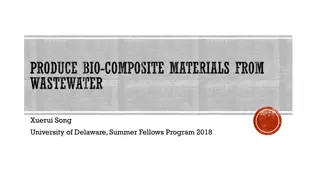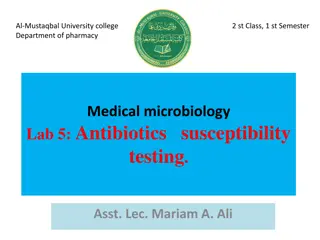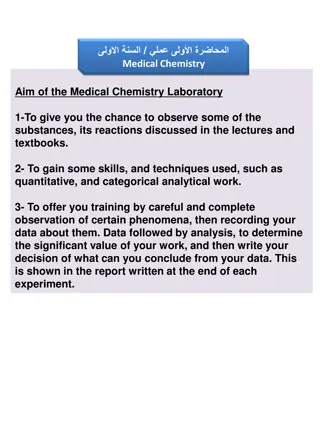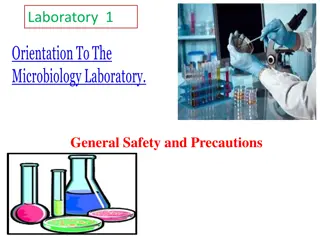Safety Measures for Growing Microorganisms in the Laboratory
In the laboratory, it is crucial to use aseptic techniques when dealing with microorganisms to prevent contamination and ensure safe growth. Understanding the importance of agar plates, Petri dishes, and incubators in creating optimal conditions for microbial growth is essential. By following proper procedures, students can conduct practical experiments to grow microorganisms safely and observe colonies forming on agar jelly. This practical activity helps students learn about microbiology and the significance of maintaining a sterile environment when working with microbes.
Download Presentation

Please find below an Image/Link to download the presentation.
The content on the website is provided AS IS for your information and personal use only. It may not be sold, licensed, or shared on other websites without obtaining consent from the author. Download presentation by click this link. If you encounter any issues during the download, it is possible that the publisher has removed the file from their server.
E N D
Presentation Transcript
Do Now S A 1.What occurs in the mitochondria? Respiration 2. Which of the following is true for mitosis?: a. all cells produced are genetically identical. b. most cells produced are genetically identical. c.All cell vary from each other. 3. Name a type of prokaryotic cell? Bacteria 4. What type of cancer is easily spread to other parts of the body? Malignant 5. Which type of stem cell can differentiate into the most cells? Embryonic.
Starter Why is it important to use aseptic techniques when growing or dealing with micro- organisms? THINK, PAIR, SHARE
Year 10 Investigating Antibiotics Key Words Antibiotics, Penicillin, Bacteria, Paracetemol, Pathogens, Virus, Specific, Resistance, Aseptic
Success Criteria You have achieved a Grade 5 if you can: Describe how to ensure the safe use of microorganisms You have achieved a Grade 6 if you can: Use aseptic techniques and explain precautions needed when handling microorganisms You have achieved a Grade 7-9 if you can: Carry out and describe aseptic techniques
The task for today. Practical Growing Microbes safely in the laboratory. Today you will describe how to grow micro- organisms safely in your book. You will then carry out a practical to grow micro-organisms found in the classroom. You will draw your plate and label it carefully.
Agar plates and Petri dishes Agar is a jelly containing a mixture of nutrients to help the microbe to grow. Petri dishes can be kept in incubators which help the microbes to grow. The lid stops unknown microbes dropping onto the agar and contaminating the The Petri dish is flat to give the microbe plenty of surface to grow on. culture. How do the Petri dish and incubator provide the best conditions for microbes to grow?
Colonies and Agar Jelly Individual microbes are difficult to see without a microscope. However, if provided with enough FOOD, WARMTH and OXYGEN (although some can live without it), they will rapidly divide to produce a COLONY. This is clearly visible to the naked eye. * We usually grow microbes in special dishes called PETRI DISHES which allow air to pass freely in and out but exclude foreign organisms and their spores. * We put a jelly-like material called AGAR JELLY in the dishes. The jelly contains food for the microbes. * All the equipment must be sterilized (heated to a high temperature) to kill any microbes that may already be there.
Colonies and Agar Jelly In school and college laboratories, cultures should be incubated at a maximum temperature of 25 C, which greatly reduces the likelihood of growth of pathogens that might be harmful to humans.
http://tbn0.google.com/images?q=tbn:ohlqiC_43HM6GM:http://pathmicro.med.sc.edu/fox/staph-impetigo.jpghttp://tbn0.google.com/images?q=tbn:ohlqiC_43HM6GM:http://pathmicro.med.sc.edu/fox/staph-impetigo.jpg Staphylococcus impetigo
Using agar plates. Any micro-organism may grow on these plates, including pathogenic ones, so there are some simple safety rules. 1. Do NOT cough or sneeze on the plates. Droplets containing microbes fly into the air when people sneeze or cough. The microbes they contain get into other people if breathed in. Chicken pox, colds, flu, measles and tuberculosis are spread like this.
The task for today. Growing bacteria in the laboratory Harmless bacteria can be grown in the laboratory on agar jelly The agar gives the bacteria food and water The plates containing the agar jelly have to be sterile that means germ-free The plates are then incubated to make the bacteria GROW
Aseptic Technique: Secure the lid with adhesive tape. Use two pieces to fasten the lid, but do not seal all the way round (this could create anaerobic conditions and encourage the growth of possible pathogenic microbes. CORRECT HANDLING TECHNIQUES Grasp the culture bottle in one hand; remove the cap with the little finger of the other hand do not place the cap on the work surface. Lift the lid of the Petri dish just enough to allow entry of the inoculating loop. Flame the mouth of the bottle for 2 or 3 seconds. Incubate at around 25oC (cultures should not be cultured at 37oC as this is an ideal temperature for the growth of many pathogenic species.) Pass the inoculating loop through the flame until red hot. Do not open the Petri dish after incubation.
Collect a handout Aseptic Technique .. cultures of microorganism are required for investigating the action of disinfectants and antibiotics. For this: - Petri dishes and culture media must be before use to kill unwanted microorganisms - inoculatingloops used to transfer to the media must be sterilised by passing them through a .. - the lid of the . . should be sealed with adhesive tape to prevent microorganisms from the contaminating the culture. In school and college laboratories, cultures should be at a maximum temperature of which greatly reduces the likelihood of growth of .. that might be harmful to humans. In industrial conditions higher temperatures can produce more growth. Missing words: micro-organisms flame Petri dish pathogens 25 C sterilised uncontaminated air incubated rapid
Self Assessment Sterile techniques Decide which are of these are safe or unsafe. Eat while you are doing microbiological work. Label your cultures carefully. Grow microbes that you know are harmful. Mix different microbes. Open containers to the air. Dispose of used cultures in strong disinfectant.
RULES! Never leave a culture dish open, even for a short time when viewing colonies of organisms, unless you intend to destroy it. When it is necessary to open a dish, keep the lid close to the dish, open it only as far and as long as is necessary to accomplish the procedure, and keep the lid between your face (and your germs!) and the agar surface.
Self Assessment Before we begin the practical, have you; described how to grow micro-organisms safely in your book. explained precautions needed when handling microorganisms and growing them safely.
The task for today. Growing bacteria in the laboratory
Practical: Growing Bacteria Draw your plate. You can either follow the instructions on your worksheet, and draw a zig zag on your agar plate, or you can try the streaking method shown in the video. Remember: Sellotape lid to the base so it cannot come off Incubate plate for at least 48 hours Examine growth of bacteria
Plenary Microbiology
Success Criteria You have achieved a Grade 5 if you can: Describe how to ensure the safe use of microorganisms You have achieved a Grade 6 if you can: Use aseptic techniques and explain precautions needed when handling microorganisms You have achieved a Grade 7-9 if you can: Carry out and describe aseptic techniques









